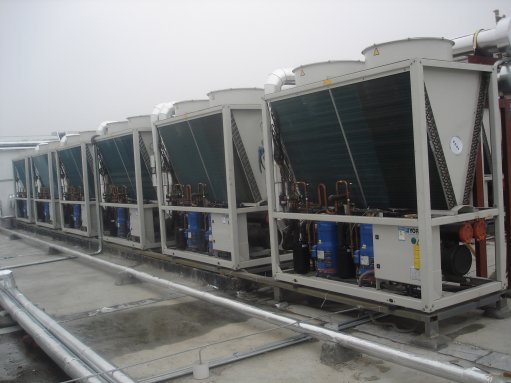
MODULAR APPROACH
Johnson Controls’ modular system can be grouped with up to eight mini-chillers that are either 40 kW, 60 kW, 80 kW, 100 kW or 140 kW
Photo by: Orange Ink
Technology group Johnson Controls launched its mini-chiller heating, ventilation and air-conditioning (HVAC) solution, which can be used in series as a modular solution, in May.
Johnson Controls building efficiency GM Neil Cameron notes that the South African market is not ideal for large, centralised air-conditioning systems, with only 10 to 20 of these systems being sold in South Africa a year.
“The need for smaller air-conditioning systems is a lot [greater] in South Africa, which is why we have been developing products suited to smaller air-conditioning systems,” he explains.
Cameron states that, in the past, people would buy inefficient small air-conditioning units, as only price and simple and quick installation were considered, not energy efficiency.
“People do not spend a lot of time going through the details and specifications of an air-conditioning system and it becomes more of a commodity product,” he states.
Cameron adds that this resulted in Johnson Controls making its less capital intensive, smaller standard air-conditioning products more efficient and feature rich by incorporating special shelling tubes or heat exchangers.
He notes that, because these smaller HVAC systems do not have variable-speed drives – which allow for load capacity control, but are more expensive – the capacity of the air conditioners installed often exceeds the demand of a building, which is an inefficient approach.
Owing to South African consumers’ price constraints, Johnson Controls promotes the concept of a modular mini-chiller system.
“This allows us to group up to eight mini-chillers that are either 40 kW, 60 kW, 80 kW, 100 kW or 140 kW to supply the necessary demand to buildings. We can create air-conditioning systems of up to 800 kW by placing them in series,” Cameron highlights.
The modular concept also provides capacity control, as individual units can be shut down when demand is not at full capacity, which saves energy. “This is a cost-effective solution, which is ideal for price-sensitive consumers who are looking for an efficient product,” he adds.
Cameron explains that energy efficiency is calculated as a coefficient of performance (COP). Johnson Controls’ modular systems have a COP of 3.3, which means that 1 kW of electrical energy produces 3.3 kW of cooling energy. A single mini-chiller has a COP of 2 to 2.2, while larger, central plants can reach a COP of up to 7.
He notes that the modular system was developed over the past 14 years at Johnson Controls’ China branch, as Chinese consumers prefer the modular approach.
“We have changed the modular system to comply with US and European energy efficiency and development standards, and the system is currently manufactured in Europe.
“One of the changes to the modular system is the addition of built-in sequence controls – a single controller that can control up to eight chillers. The system can also communicate with building management systems.
Johnson Controls Building Efficiency has 110 factories globally and the mini-chillers are imported from its Spain factory.